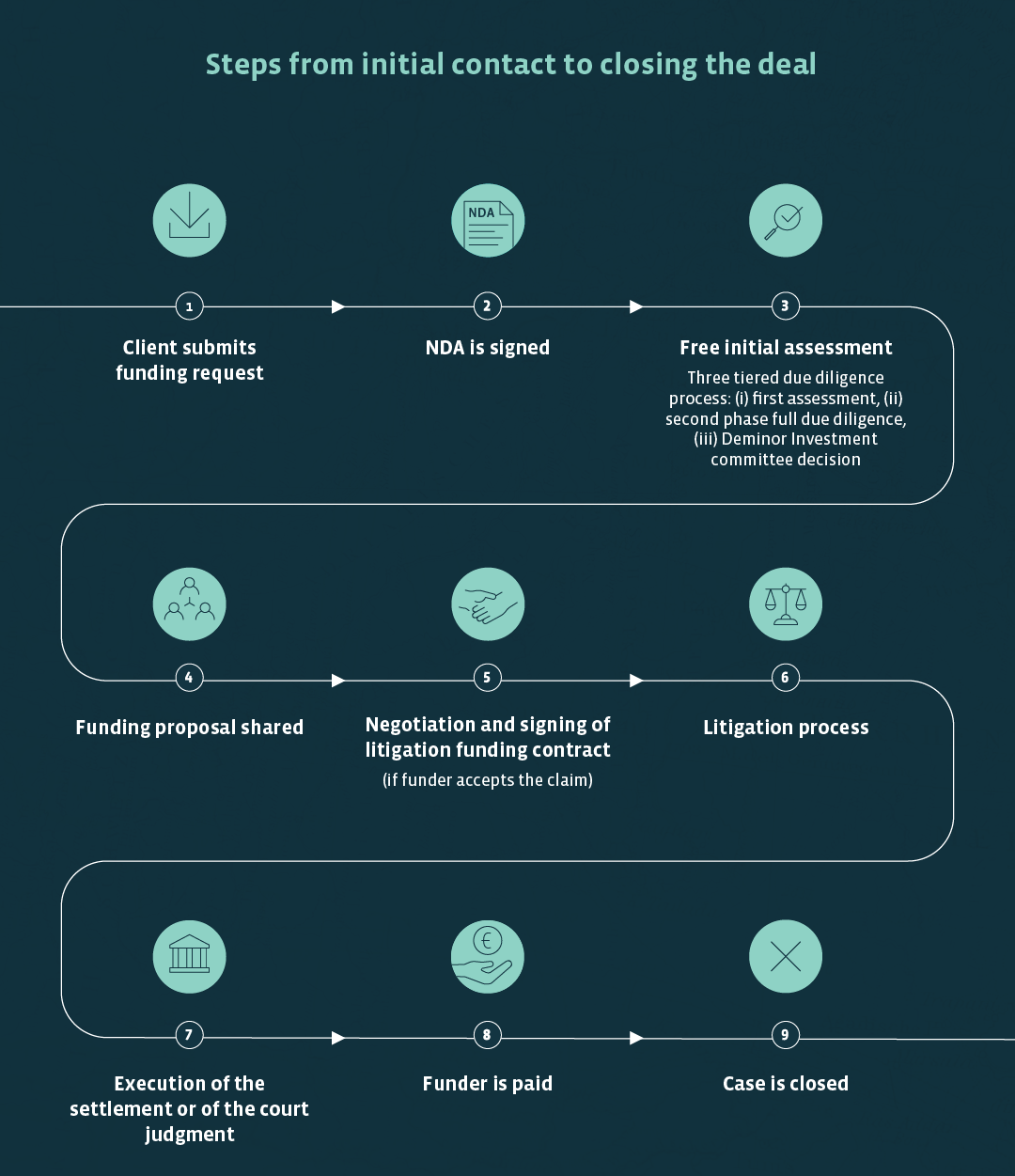
What is Litigation Funding?
Litigation funding is a financial arrangement where a third-party funder covers the legal expenses of a claimant or plaintiff. Typically, funds are provided on a ‘no cure, no-pay’ basis, meaning the funder only receives a portion of the settlement if the case is successful.
Page Contents:
- Litigation Funding - Overview
- Benefits of Litigation Funding for Businesses
- Articles: The Business Benefits of Litigation Funding
- What type of legal claims can be funded?
- What type of Proceedings can be funded?
- What costs are covered by litigation finance?
- How does Litigation Funding Work?
- Litigation funding agreement
- Litigation Funding Case Studies
- Considerations when dealing with a third-party funder
- Third Party Funding - International Landscape
Litigation Funding - Overview
Modern Litigation funding, also known as ‘Third Party Funding’ or ‘Litigation Finance’, is a form of legal finance in which a third-party provides financial resources to a claimant or plaintiff in exchange for a financial return in the event the case is successful.
This return typically takes the form of a share of the proceeds or an agreed percentage of the funder’s investment, structured through transparent and regulated agreements that comply with industry standards such as those set by the International Legal Finance Association (ILFA), the Association of Litigation Funders (ALF) or European Litigation Funders Association (ELFA).
If the case is lost, the funder loses their investment, making it a ‘non-recourse’ financing solution (‘no cure, no pay’).
Legal Financing enables claimants or plaintiffs to pursue legal action without bearing the full cost of litigation upfront. The costs of legal representation, court fees, and other expenses can be prohibitive, and a claimant may not be able to pursue due to insufficient financial resources, even with a strong case.
The benefits of commercial litigation finance mean it is an increasingly common funding mechanism for dispute resolution or arbitration. Law firms and corporations use litigation funding as a strategic risk management tool to improve cash flow and remove legal costs from the balance sheet. Well-capitalised companies are increasingly leveraging litigation finance to optimise their financial resources.
Litigation funding is also used in collective actions where the individual cost for each individual plaintiff would outweigh the benefits. Therefore, using a litigation funding model to bundle the claims enables the claimants to benefit from cost-sharing whilst also shifting the costs and risks to a third-party funder, thus making such claims (and thereby access to justice) economically viable.
In an era where legal battles can be prohibitively expensive, litigation funding empowers businesses and individuals to pursue justice without financial burden.
Third Party Litigation funding (TPLF) has deep historical roots (the concept of legal finance has existed for centuries), but the industry experienced significant expansion in recent decades, with an increasing number of funders and funding solutions now available.
Benefits of Litigation Funding for Businesses
Elimination of Litigation Costs
A key benefit of working with a commercial litigation funding funder is that a business can remove the cost of litigation from its balance sheet and thus incur no financial risk in undertaking litigation, no matter how complex or lengthy the case might become.
Optimal allocation of working capital
Litigation can be capital-intensive. Working with a third-party funder means a business can avoid financial uncertainty and associated costs. As a result, corporations can retain core working capital within the business and invest funds directly into activities related to business development and value creation. By removing financial constraints, companies can allocate capital to revenue-generating activities that deliver a return on investment.
Removal of financial limitations or barriers
Not all companies have the financial resources to pursue litigation, even if they have a strong claim or case. Litigation finance helps to solve this problem by providing the required financial resources. In doing so, companies that may have been unwilling to file a legal claim due to financial or business constraints are able to pursue or defend a claim.
Remove legal department constraints
By leveraging third-party funding, companies can remove financial constraints that might otherwise limit their legal department's capabilities. This enables the department to pursue claims that would have remained dormant, transforming it from a cost centre into an ancillary profit centre. With access to external funding, the legal team can optimise resources and contribute more strategically to the company's financial success.
Strength by association
Working with a professional, experienced litigation funder sends a powerful message to the opposing party that they will pursue the claim until a reasonable outcome has been achieved and that resources are no longer an obstacle.
Achieving optimal recoveries
Working with an experienced commercial litigation funder can provide clients with more than just financial resources. It can provide access to a diverse network of international legal professionals, economic experts and enforcement specialists, to maximise the chance of recoveries.
What type of legal claims can be funded?
There are no real restrictions to the type of legal claim that can be funded. As long as the funder believes that the claim has merit and that it can be acted upon in a mutually agreed-upon manner, the funder may propose its services for nearly any type of legal case including, but not limited to:
- Breach of contract
- Corporate law claims (shareholder, M&A and JV disputes)
- Anti-trust claims (individual or collective)
- Losses on financial instruments
- Investment and financial markets claims
- Insurance claims
- Intellectual property claims
(breach of patent) - Tort claims (losses caused by wrongdoing)
- Tax Claims
Claims that lack economic value, such as restraining orders or injunctions in intellectual property cases, are also not excluded, but both parties will have to carefully define the conditions governing the funder’s intervention. Because the litigation funder is only paid upon the successful conclusion of the case, the contract must outline all possible outcomes and identify what is considered “success”. For claims without economic value, the funder will generally be paid based on a multiple of the total amount invested rather than a percentage of the case proceeds.
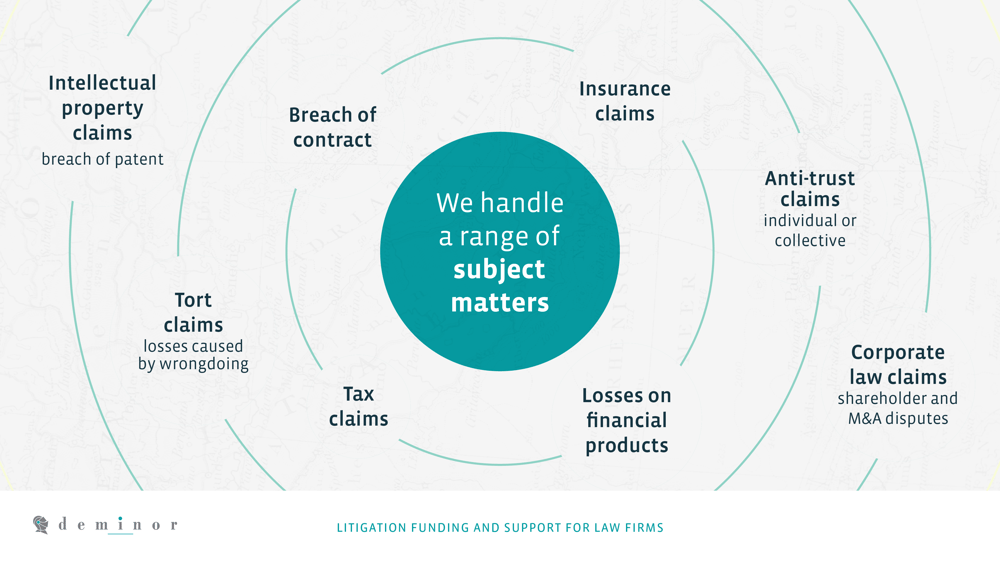
- Proceedings before the ordinary courts
- Enforcement proceedings
- Alternative dispute resolution proceedings
- Settlement proceedings
- Arbitration proceedings
- Mediation
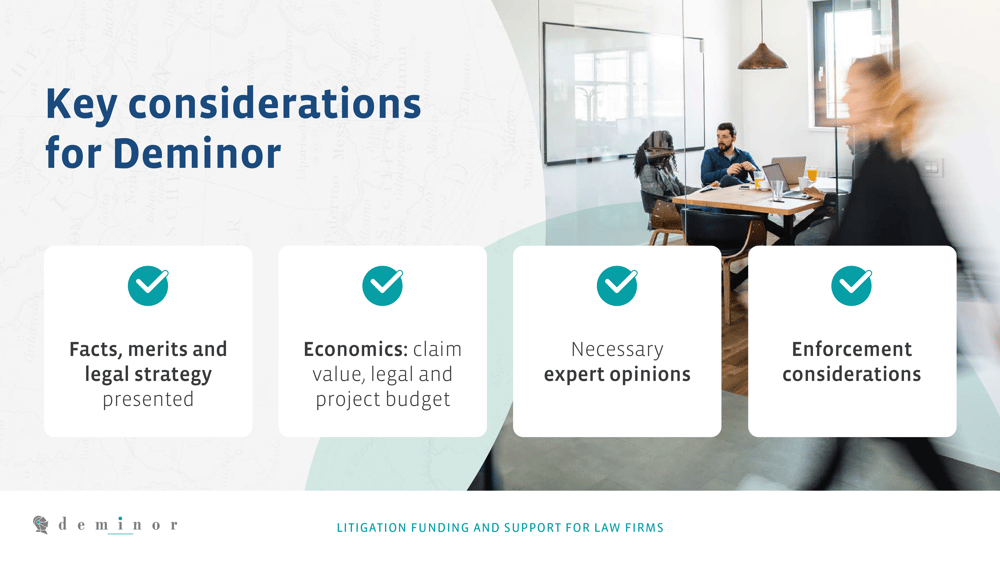
- Lawyer fees
- Expert fees
- Court costs
- Costs of taking evidence & document collection
- Costs of arbitration institute and arbitrators’ fees
- Security for costs (if applicable)
- Adverse party fees (in case of loss)
- Translation, travel and other out-of-pocket expenses
The objective is to transfer all financial risks of litigation from the litigating company to the litigation funding company.
How does Litigation Funding Work?
Litigation funding provides financial resources to claimants or plaintiffs to pursue a legal claim. Funding is provided by a third-party investor, who enters into an agreement with the claimant or a legal representative. The specifics of how litigation funding works will depend on the requirements of the funder.
Litigation funding approval process
Taking a potential case from an initial enquiry to being fully funded can be a complex process and would commonly go through the following steps:
- Funding request submission
- NDA is signed
- Free initial assessment
- Funding proposal is shared
- Signing of Litigation Funding Contract
- Litigation Process
- Execution of settlement or court judgement
- Funder is paid
- Case closed
The process will typically involve an initial request for funding followed by an extensive due diligence process by the third party investor to evaluate the prospects of a successful claim and likelihood of recoverability should a judgement be enforced.
Due diligence process
Due Diligence is carried out in detail by the funder to determine how viable the case is to invest in. Alongside merits of the case, a funder will place significant focus on risk as to mitigate future losses.
Typically, the review encompasses three stages:
- The first phase of due diligence examines the key issues of the claim and proceedings in order to elicit if it is suitable for funding. Depending on the internal skills and experience of the funder, this may be carried out by the internal team, which can have a notable impact on the speed at which an initial decision is made.
- In the event of a positive phase 1 due diligence process, the claim then progresses to phase 2, encompassing detailed due diligence of the proceedings, details and risks of the claim, along with the economics of the investment. At this point, it can be common for a funder to gain the objective view of an independent third-party expert on the merits of the case.
- If a case passes both phases 1 and 2, it is then normally escalated to something commonly referred to as an Investment Committee. This is where a decision is made to fund and on what terms. Depending on the complexity of the case, this process could take a number of weeks and possibly months.
If the outlook of the claim looks positive and the funder believes there is a strong likelihood of success, a proposal will be sent. if all parties are in agreement and wish to proceed a litigation funding agreement will be issued. The litigation funding agreement outlines the terms and conditions of the funding, including the percentage of damages awarded or settlement reached that the investor will receive in return for investing in the claim.
Once the agreement is signed, the funder will provide the required capital in line with the terms agreed. If the case is won, the funder will charge the agreed success fee. If the case is unsuccessful, the claimant and no compensation is recovered, the funder will lose the investment, and the claimant will not be liable for any associated costs.
To learn more about Deminor’s litigation funding process, visit our article on how litigation funding works.
Is there a minimum claim size?
The minimum claim size required to secure legal finance can vary depending on the specific funder and the terms of the funding agreement. Some litigation funders may require a minimum claim size of €1 million or more, while others may consider smaller claims on a case-by-case basis, especially if the claim is straightforward and incurs limited budget and risk.
Other third party funders may simply fund claims based on the ratio between the estimated case costs and the potential gains, and not require a minimum claim size.
What percentage do litigation funders take?
If the case concludes successfully, the funder's remuneration will be calculated either as a percentage of the total underlying claim value secured or as a return on the amount invested in the case. It could also be a blend of these two approaches.
The type of remuneration will depend on the type of claim, agreed control rights, enforcement issues and whether the case was fully or partially funded. A funder will only receive compensation if the case is successfully concluded as per the stipulations of success laid out in the contract. If the case is lost, the client will not have to reimburse the funder, and the funder will suffer a net loss.
Who makes key decisions?
Within the litigation funding process, the client remains the ultimate decision maker, and funders do not have the right to veto or impose decisions as they are passive investors. However, to mitigate risk on their behalf, funders may lay out caveats to protect their interests within the funding agreement.
Once funding is agreed upon, the funder is directly interested in the outcome of the case throughout the claim's lifecycle, as developments can impact remuneration and return on investment. As they have an important stake in the outcome of the case, funders will want to be informed of all material developments.
As a result, the interests of both the client and the funder are naturally aligned throughout the process: in this context, the successful (most favourable) conclusion of the case. The funder will usually play a minor role in the case. However, if case management is delegated to the funder, such delegation will only include decisions on day-to-day case management.
Strategic decisions, such as accepting a settlement, withdrawing a claim, or filing an appeal, will always require the client’s consent. Depending on the contractual funding terms, the funder may need to be consulted, or consent may be required for certain key decisions that have an impact on the funder’s return.
Who selects the lawyer?
Typically, the claimant or their legal representative will select the lawyer who will manage the litigation. However, some litigation funders may require the approval of the lawyer or legal team prior to agreeing to fund the case.
It is within the best interests of the client as well as the funder to work with the most appropriate law firm. Equally, if the client has a preferred law firm that is familiar with the company and has the required expertise to bring the case to a successful conclusion, the funder will normally aim to be flexible and work with the client’s preferred counsel.
Conditions for legal funding
If a client wants to file a claim (or is being sued, in some cases), the first stage might be to contact more than one litigation funder to find a company that specialises in the claimant’s exact type of dispute. This is because it is common for Litigation Funders to specialise in different types of claims, and therefore, it is in the best interest of the claimant (and their legal representation) to find the funder who is best suited to support their needs.
The funder's team will then perform due diligence on the case to determine whether the client has a viable cause of action. The due diligence exercise is typically completed by a team of legal and financial experts and is offered at no cost to the client. At all times, the funder normally remains free to accept or refuse the funding of a claim.
Who manages the litigation?
Usually the role of the litigation funder is limited to providing the financial resources only, with the client managing the litigation with its counsel. It is normally expected to ensure the funder is kept informed about all developments in the case, and may even offer some passive support at the request of the client or its counsel. Strategic decisions that potentially impact funding (and thus, the funder's interests) may, however, require consent.
The client and its counsel will discuss the best decision to make, i.e. whether or not to settle or whether or not to file an appeal. Depending on the contractual terms of the funding, the funder's advice or consent will be required before taking certain decisions which may have a major impact on the funder’s return.
If interests are no longer aligned between the funder and the client, and the client wishes to terminate litigation because of other pressing business matters (such as a possible merger, for example), the client should typically have access to a termination clause and will have to indemnify the funder in accordance with the contractual terms.
Litigation funding agreement
If a claim successfully completes all stages of due diligence the funder will issue what is known as a ‘Litigation Funding Agreement’ in which both parties will discuss and agree on the terms and conditions of the funding, including the remuneration to be received by the litigation funder in the event of a successful outcome to the proceedings.
The remuneration varies per case and will depend on the type of claim, the anticipated duration, its chances of success and its jurisdiction. It is also possible to receive partial funding (covering, for example, only the security for costs or the lawyer’s fees) if the client seeks to limit the funder’s involvement and reduce its fees.
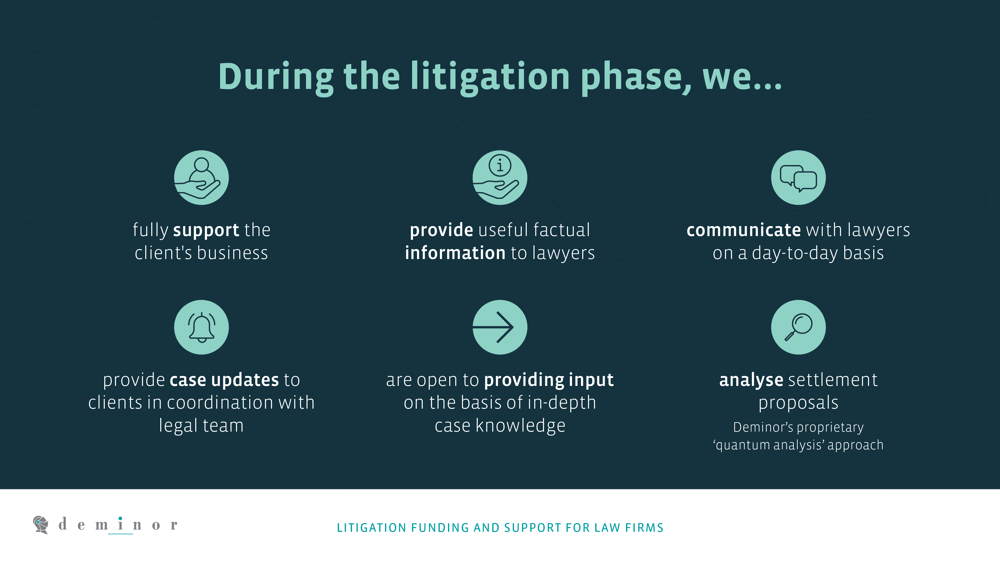
Considerations when dealing with a third-party funder:
What makes a good funder?
The added value of a good litigation funder can often be seen in the funder’s ability to communicate and provide the best client care during dispute resolution. However, there are also several financial and legal considerations that need accounting for when assessing how to choose a litigation funder.
Typical considerations that are often examined before approaching a litigation funder include:
Preferred investment type and specialisms
Does the funder specialise in the type of case or claim you're pursuing?
Preferred investment size
What is the funder’s preferred range for investment, and does it match your case’s financial needs?
Risk appetite and preferred risk allocation model
How willing is the funder to take on risk, and how do they structure risk-sharing?
Funder's capital reserves to commit to funding the litigation over time
Does the funder have the financial resources to commit to your case over its full duration?
To help with assessing the quality of a third-party funder, litigation funding rankings, such as Chambers & Partners Legal 500 or Leaders League, examine funders within numerous international jurisdictions. While not wholly summative of a funder's quality, these rankings evaluate a litigation funder's team size, specialism, decision-making process, budget availability, awards, accolades and media coverage.
An additional marker of a good funder is whether they are members of associated industry bodies that follow a rule of best practices for litigation funding, such as the International Legal Finance Association (ILFA), the Association of Litigation Funders (ALF), which acts as self-regulatory body for funding within England and Wales, or the European Litigation Funders Association (ELFA), which is the collective voice of funders across Europe.
Third Party Funding - International Landscape
Regulation Restrictions in Certain Jurisdictions
Litigation funding is permitted in most European civil law countries. Common law countries used to prohibit litigation funding based on the ‘champerty and maintenance doctrine’. These rules prevented the assistance of unrelated third parties in legal claims and the sharing of proceeds with any assisting third parties.
These doctrines have been abolished in the UK, and litigation funding is commonplace in Australia and the United States. In general, however, funders cannot exercise control over the litigation in common-law jurisdictions. Certain common law jurisdictions in Asia, including Singapore and Hong Kong, prohibit the funding of commercial litigation but allow arbitration funding or funding provided to insolvency practitioners. Other Asian countries either permit litigation funding or have not yet regulated it, including Japan, South Korea, Taiwan and China.
Litigation funders must comply with any applicable laws and regulations. Where required, funding agreements must be adapted to comply with local regulatory restrictions.
Litigation finance - Insights from global markets
For an in-depth understanding of litigation finance across different jurisdictions, the articles below provide insights into the different legal and regulatory frameworks and historical context.
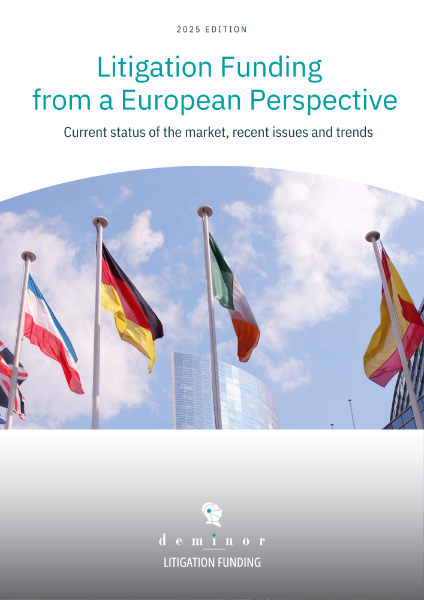
Litigation Funding from a European Perspective
Litigation funding opportunities are rising in Europe as the market matures and responds to a shifting landscape shaped by new regulations, COVID upheaval and societal change.
In this whitepaper we take a closer look at what’s driving change in the region and the issues claimants and funders should consider if they are to successfully navigate their way through it.
Download the whitepaper now

